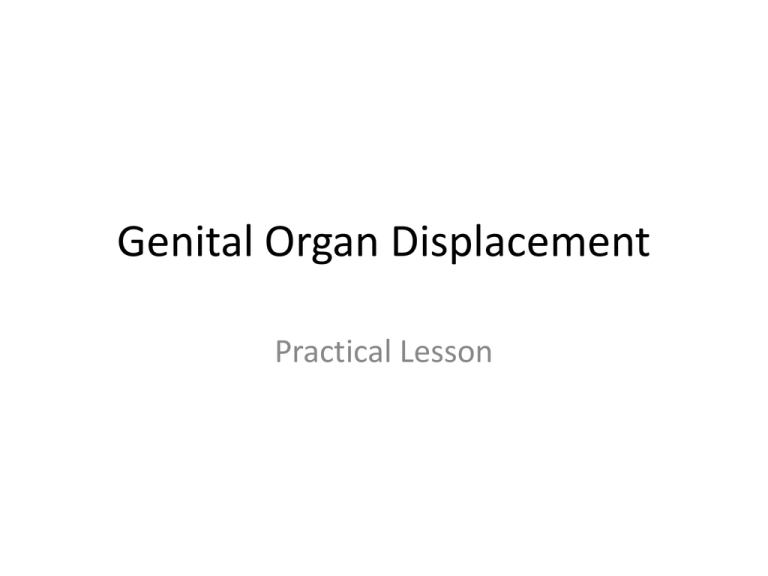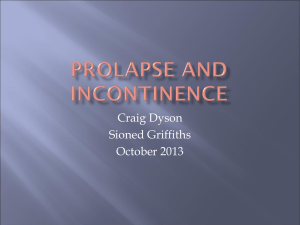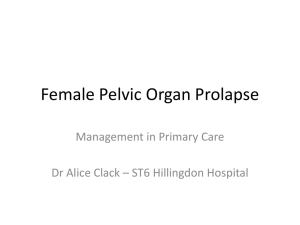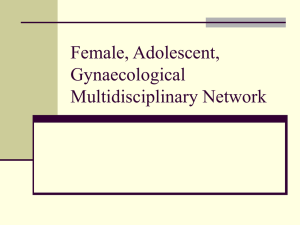Genital Organ Displacement- Practical Lesson
advertisement

Genital Organ Displacement Practical Lesson Vaginal Wall Prolapse • Anterior vaginal wall prolapse: 1- Cystocele: It is the commonest type of prolapse. It is a bulging of urinary bladder base in upper ¾ of anterior vaginal wall between bladder sulcus and transverse vaginal sulcus. 2- Urethrocele: Bulging of urethra in lower ¼ of anterior vaginal wall between transverse vaginal sulcus and submeatal sulcus. It is very rare to be present alone. 3- Cysto-urethrocele: Total (complete) anterior vaginal wall prolapse. The prolapsed tissues lies between bladder sulcus and submeatal sulcus. • Posterior vaginal wall prolapse: 1- Enterocele: It is the descent of the upper part of posterior vaginal wall, lined by peritoneum of Douglas pouch, containing intestine. It has a hernial sac that has an orifice. 2- Rectocele: It is the descent of the lower part of posterior vaginal wall, it occurs usually with perineal tears. • Vaginal vault prolapse Sometimes occurs after total hysterectomy. 2 3 Sulci Bladder Ts Vag SubM. 4 5 6 7 8 Uterine Prolapse • First degree uterine prolapse: – Cervix lies below the ischial spines, but it does not appear through the vulva. • Second degree uterine prolapse: – Cervix and part of the uterine body appear through the vulva. • Third degree uterine prolapse (procedentia): – The uterus (cervix and body) lies outside the vulva and fingers can be approximated above the fundus. 9 10 11 12 13 14 15 Combined Prolapse • Utero-vaginal prolapse: – Uterine prolapse starts first followed by the vaginal prolapse. – It occurs in young age and it is associated with congenital predisposing factors. – The vagina is inverted with no cystocele. • Vagino-uterine prolapse: – Vaginal prolapse starts first followed by the uterine one. – It occurs in old age and it is associated with acquired predisposing factors. – The vagina is inverted with large cystocele. 16 Clinical Picture • Symptoms: – Mass (due to descent): • A lump in the vagina in case of vaginal wall prolapse. • A patient with uterine prolapse may complain of a mass (cervix) protruding from the vulva on straining and it disappears on lying down (2nd degree), or the cervix may not disappear unless the patient pushes it upward [Procedentia “3rd degree”]. – Pain (due to stretch of ligaments): • Low backache (most dominant) which is relieved by lying flat or temporarily using ring pessary to support the prolapse. • Dragging suprapubic and inguinal pain or disomfort – Vaginal and sexual symptoms: • Blood-stained, sometimes purulent vaginal discharge. – Vaginal discharge due to pelvic congestion or 2ry infection of trophic ulcer • Patulous vagina and lack of sexual satisfaction for the patient and the husband 17 18 • Examination: – General and Abdominal Examination • predisposing factors, precipitating factors and complications of prolapse • prepare patients for surgery. – Local Examination: Two separate evaluations must be made, first with the patient at rest, and then, under conditions of maximal straining (Valsalva maneuver). – Inspection: • Stress incontinence is most likely to be demonstrated if the bladder is full • Type and degree of prolapse: – Vaginal prolapseanterior and posterior vaginal wall prolapse. – Uterine prolapse: the cervix is apparent in 2nd and 3rd degrees • If the cervix protrudes outside the vagina, – may be ulcerated and hypertrophied, with thickening of the epithelium and keratinization. – A full pelvic examination: • Exclude pelvic mass that may have caused the prolapse. • Palpation: – Clinical tests for stress urinary incontinence. – Type and degree of prolapse: » Vaginal Prolapse: differentiate cystocele from urethrocele and differentiate rectocele from enterocele. » Uterine diagnose 1st degree and differentiate 2nd from 3rd degree. – Testing the Levator Muscles Tone: » All prolapsed parts are replaced within the pelvis. » Two fingers are inserted into the vagina and the patient is asked to close off her vagina against the examining fingers. » The levatores are palpated 19 – Bimanual examination for the uterus, ovaries, adnexa, and Douglas pouch. – Urinary tract symptoms: • Stress incontinence (SI) is the commonest. – descent of the urethrovesical junction or – if delivery and repeated operations have produced scarring around the urethra and bladder neck leading to inadequate urethral closure. – Cystourethrocele is not the sole cause of SI and there presence is sometimes is just a mere association. • Voiding difficulty can occur if a large cystocele is present and bladder neck is anchored normally. – This can lead to retention followed by overflow incontinence. – It can be corrected temporarily by manually replacing the prolapse (the patient needs to “splint” her vagina to micturate). • • Frequency (during the daytime) and inadequate emptying (sense of incomplete act) if sufficient urine is being voided but a chronic residual urine remains. A urinary tract infection may supervene. – In case of infection (on top of stasis) and stone formation, there are frequency day and night, dysuria, and urgency. – Rectal symptoms: • • • Incomplete bowel emptying, Constant desire for defecation, increased frequency of defecation. Dyschesia and piles may develop due to straining. 20 • Investigations: – To detect predisposing or precipitating factors: e.g. x- ray chest, and abdominal U/S. – Preoperative preparation: These are very essential, CBC, urinary investigations (IVP, urine analysis, urine culture and sensitivity, kidney function tests). 21 DD • Anterior Vaginal Wall Prolapse: – Differentiation of anterior vaginal wall prolapse from other conditions: • Congenital anterior vaginal wall cysts e.g. Gartner’s cyst. – – • • – The gartner’s cyst appears lateral to the midline. It is not compressible and irreducible. On the other hand, a cystocele appears on standing or straining. It is reducible and compressible. If a catheter is passed, it can be felt in the mass. Urethral diverticulum is compressible and urine comes out with local pressure. Inclusion dermoid cyst following trauma or surgery. Recognition of the type of anterior vaginal wall prolapse, whether cystocele or urethrocele 22 • Posterior Vaginal Wall Prolapse: – Rectocele Vs Implantation Dermoid /Vaginal cyst. • • – Rectocele: appears on standing or straining. It is reducible and compressible. If a finger is introduced in the rectum it can be felt in the mass. Posterior vaginal wall cysts: implantation dermoid (the commonest). It is irreducible and incompressible. A finger in the rectum can not be introduced in the mass. Rectocele Vs Enterocele • • Rectocele: it is the prolapse of the lower 2/3 of posterior vaginal wall. On reduction, it is empty (no gurgling). It does not give impulse on coughing. Per rectum exam, a finger gets inside the mass. Enterocele: it is prolapse of upper 1/3 of posterior vaginal wall. Gurgling sensation on palpation (because intestine contains air). Positive impulse on coughing (may be seen or felt). Per rectum exam, the mass is out of reach of the finger (the rectum is pushed backwards by the swelling and is not forming a part of the mass). 23 Uterine Prolapse Uterine Prolapse Old age and high parity. External os appears outside the vulva with shallow fornices. Elongation of suprvaginal portion of cervix It yields on straining and in volsellum test. In 3rd degree prolapse the thumb and fingers can meet together above the fundus of uterus when the uppermost portion of the prolapsed mass is palpated (finger test or grip sign). Congenital Elongation of the Cervix Young age and in nulligravida. The fornices and the vaginal vault are at the normal level (the level of ischial spines). The Portiovaginalis portion of cervix is elongated It does not yield on straining and/or upon traction with a volsellum. 24 Differentiation between uterine prolapse and masses protruding from the vulva • Fibroid polyp: – absence of external os. – The cervix is at its normal position with the pedicle of the tumor coming out through the cervix. – A sound can be introduced for long distance inside the uterine cavity. • Inversion of uterus: – – – – absence of external os. the mass is covered by smooth endometrium. the body of the uterus is not felt per abdomen. A uterine sound can be introduced for a short distance or cannot be introduced at all. • A cauliflower carcinoma or sarcoma of cervix or vagina may appear at the vulva. – The mass is friable, necrotic, indurated at the base and bleeds on touch 25











